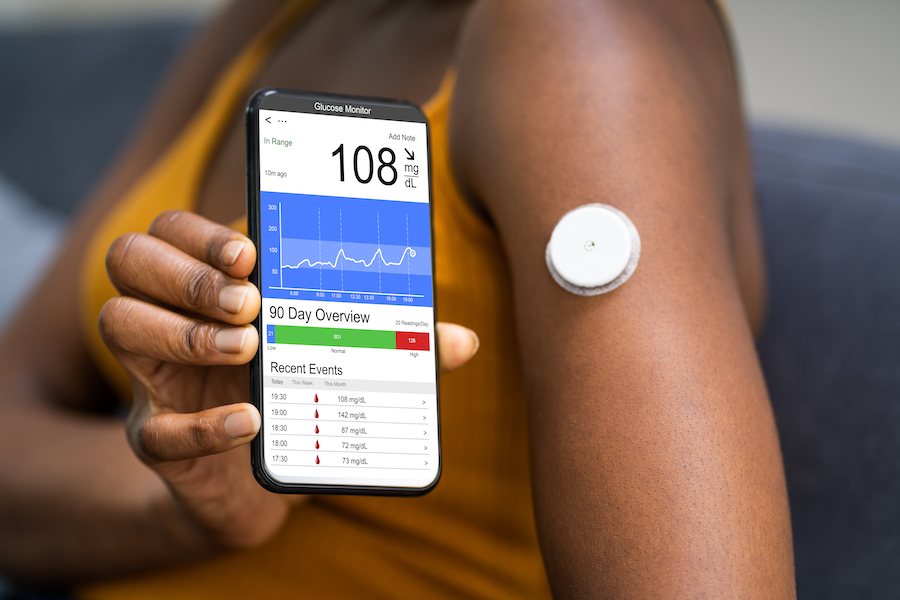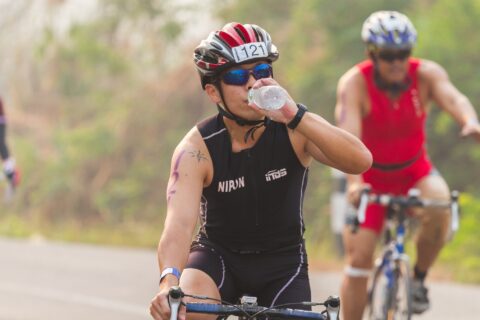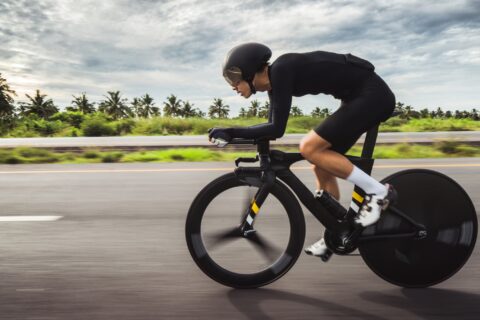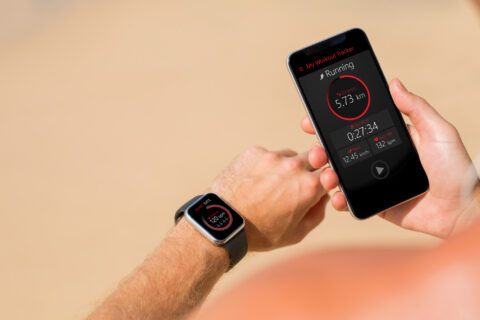Not long ago, continuous glucose monitoring was a tool used mainly by diabetics. Now, multiple manufacturers make devices called continuous glucose monitors (CGMs) that utilize a small sensor, typically applied to the arm or belly area, to detect glucose. Endurance athletes have been quick to adopt this new technology to improve training and racing performance.
In 2021, however, cycling’s international governing body, the UCI, banned the use of devices that capture and report information on metabolic values during competition. This ban includes, at a minimum, glucose and lactate measurement. (Read more about the UCI’s regulations here.) At the time of this article’s publication, the devices were still allowed in triathlon competitions.
Before a CGM can be used, an applicator attaches a plastic disc and a small needle-like sensor just below the skin. Adhesive tape holds the sensor in place. The sensor then measures glucose levels in the fluid beneath the skin and, at regular intervals, sends the measurements to a wearable fitness device, cycling computer, or smart watch. The user can see real-time data and gain insights into how their body responds to various nutrition sources and combinations of foods for continuous glucose monitoring.
RELATED: Sports Nutrition Pathway
Why is this information so valuable? In part it has to do with the variability of individual responses to nutrition. A study published in 2015 followed 800 people and showed that people’s responses to any food can be very different. Understanding how your body responds to foods can help you eliminate glucose spikes and crashes, helping you feel better and improve performance. During training and racing, these CGM devices can help athletes fuel more efficiently and possibly prevent the dreaded bonk.
So, this begs this question: Should continuous glucose monitors be allowed for use by athletes during endurance sports competitions? We asked two prominent endurance coaches to debate the merits of either position.
Carson Christen Argues Against CGMs in Races
First it was index shifting, then heart-rate monitors, followed by power meters. And now we have CGMs. Endurance sports have historically looked for new ways to achieve better performance, with athletes and teams spending millions of dollars for the smallest of gains—gains which may mean the difference between a gold medal or no medal. So, anything that can be done to increase the likelihood of winning should be used, right? Perhaps not.
Nowadays, it is common to hear cycling fans complain about how races have become robotic. Heart-rate monitors, race radios, and power meters allow certain teams and athletes the ability to execute very predictable, robust strategies. Is this necessarily a bad thing? No. At the same time, it’s refreshing to see race results that are a function of an athlete’s ability to deal with the terrain, weather, team tactics, or other elements based on their own merits. After all, unpredictability is part of what makes racing fun. Preventing athletes from using continuous glucose monitors during races could reduce some of the robotic nature of endurance sports and keep the art of fueling on the table as a requirement for success.
Some argue that continuous glucose monitors should be allowed for safety’s sake, so that athletes are fueled and mentally acute. Fair point, though I would argue it is the duty of the racers and the teams to ensure that athletes are educated on fueling and have enough carbohydrate (glycogen/glucose) to meet the demands of the performance. This is especially true for professionals.
Failure to fuel correctly may lead athletes to lose minutes on a mountain stage, for example. This is all part of sport. It shouldn’t be seen as a negative. Racers should have trained to handle the stressors and responses that make up a successful race day. If they fail, it’s a learning opportunity for next time.
I would also argue against the use of CGMs because they add one more potential cost to the athlete’s toolbox, thereby creating a barrier to entry for some. The arms race of in-competition technology shouldn’t be applauded. Some athletes cannot afford CGMs and shouldn’t be punished because they have smaller bank accounts.
Finally, we must see more evidence to suggest the data from CGMs is reliable and meaningful, and corresponds to what is actually happening in the body. Using these devices in training as a learning tool is fine, but preventing the use of CGMs on race day to minimize robotic racing and keep the art of racing is encouraging. I believe the UCI’s ban on CGMs has merit.
Carson Christen is an exercise physiologist and head coach and owner of Torden Multisport. He is coach to amateur and professional cyclists and triathletes worldwide, which includes five national champion cyclists and an Olympian.
Suzanne Atkinson Says Yes, Allow CGMs During Races
Are you looking for ways to dial in the optimal nutrition strategy and create a safer way to manage energy during training and racing? If so, then a CGM might be the way to go. These devices provide detailed data which helps to monitor blood sugar levels and nutritional consequences, which enables more effective training and racing regimes.
Even for athletes who don’t have diabetes, having insight into the body’s individual response to carbohydrate and protein intake while racing will help you minimize unneeded fueling and excessive exposure to sugars.
This can improve long-term health by minimizing inflammation and elevated insulin levels long after the race is over. Managing energy surges and slumps allows faster reaction times and better decision making as well. As a result, the likelihood of a crash or accident due to mental fatigue may be significantly reduced.
Because CGMs offer real-time feedback in race situations, athletes can quickly make effective adjustments so that they can optimize performance and reach their goals. Ultimately, CGMs simply provide users with deeper insight into some of the variables that influence performance. How is using a CGM any different than using a heart-rate monitor or a power meter during races? There is no difference. A CGM is just another tool to help athletes understand and optimize performance.
Some people may argue that using a CGM while participating in cycling or triathlon events should be banned, but there are many benefits to having continuous access to this information. Having real-time data about glucose levels not only provides low blood sugar detection, but the data can also help ensure your body has the energy it needs to recover quickly.
Cycling coach Hunter Allen is an advocate for the use of CGMs, and encourages athletes to consider using them during training and racing. He said: “Using a CGM in racing allows the racer to carefully manage their energy levels and creates a safer environment.”
Instead of using a generic one-size-fits-all fueling strategy based on bodyweight and gender, endurance athletes can take charge of their nutrition by utilizing a CGM under various conditions. By understanding how every individual body responds to various combinations of carbohydrate, fat, and protein in various training and racing conditions, athletes can take steps to avoid dreaded energy crashes and optimize performance.
Suzanne Atkinson, M.D., is an emergency medicine physician and USAT Level 3 triathlon coach who has been coaching endurance athletes since 2005. She is the long-time coach of world champion triathlon and Paralympic triathlon guide Kirsten Sass.
Gale Bernhardt has coached Olympians and professional and recreational endurance athletes for years. Some want to go faster, some want to cross the finish line, while others simply want endurance sport as a lifestyle. She provides ready-to-use, easy-to-follow training plans for cycling and triathlon.
References
Zeevi et al., 2015, Cell 163, 1079–1094, November 19, 2015




